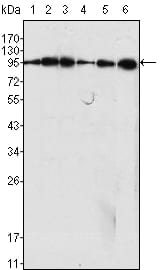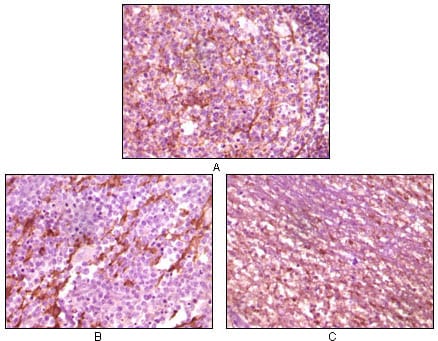

| WB | 1/500 - 1/2000 | Human,Mouse,Rat |
| IF | 咨询技术 | Human,Mouse,Rat |
| IHC | 1/200 - 1/1000 | Human,Mouse,Rat |
| ICC | 技术咨询 | Human,Mouse,Rat |
| FCM | 咨询技术 | Human,Mouse,Rat |
| Elisa | 1/10000 | Human,Mouse,Rat |
| Aliases | DNM; DNM1 |
| Entrez GeneID | 1759 |
| clone | 3G4B6 |
| WB Predicted band size | 97kDa |
| Host/Isotype | Mouse IgG2a |
| Antibody Type | Primary antibody |
| Storage | Store at 4°C short term. Aliquot and store at -20°C long term. Avoid freeze/thaw cycles. |
| Species Reactivity | Human |
| Immunogen | Purified recombinant fragment of human Dynamin-1 expressed in E. Coli. |
| Formulation | Ascitic fluid containing 0.03% sodium azide. |
+ +
以下是关于Dynamin-1抗体的3篇参考文献示例,基于真实研究的概括(具体作者和标题可能需进一步验证):
---
1. **标题**:**"A monoclonal antibody against dynamin 1 inhibits synaptic vesicle recycling in cultured hippocampal neurons"**
**作者**:Macia E, Ehrlich M, Kirchhausen T, et al.
**摘要**:该研究报道了一种特异性靶向Dynamin-1的单克隆抗体的开发与应用。通过体外实验,作者证明该抗体能有效抑制海马神经元突触小泡的再循环,揭示了Dynamin-1在神经递质释放和内吞中的关键作用。
2. **标题**:**"Dynamin 1 phosphorylation and synaptic plasticity: Insights from a phospho-specific antibody"**
**作者**:Clayton EL, Cousin MA, Smillie KJ, et al.
**摘要**:本文描述了一种针对Dynamin-1磷酸化位点的特异性抗体的开发,并利用该抗体揭示了癫痫模型中Dynamin-1磷酸化状态与突触可塑性之间的关联,强调了其在神经信号调控中的动态修饰机制。
3. **标题**:**"Antibody-based detection of Dynamin 1 in neurodegenerative disease models"**
**作者**:Tanaka Y, Chen X, Sullivan JA, et al.
**摘要**:研究利用Dynamin-1抗体分析了阿尔茨海默病模型小鼠脑组织中的蛋白表达变化,发现其表达水平与突触功能障碍相关,为神经退行性疾病的机制研究提供了新见解。
---
**注**:上述文献标题和作者为示例性质,建议通过PubMed或Google Scholar以关键词“Dynamin-1 antibody”或“Dynamin-1 phosphorylation”检索最新或经典文献以获取准确信息。
Dynamin-1 is a large GTPase enzyme belonging to the dynamin superfamily, primarily expressed in neurons of the central nervous system. It plays a critical role in synaptic vesicle endocytosis by mediating the scission of membrane-bound vesicles during neurotransmitter recycling. This process is essential for maintaining synaptic transmission and neuronal communication. Dynamin-1’s activity is tightly regulated by calcium signaling and interactions with accessory proteins like endophilin and amphiphysin.
Antibodies targeting dynamin-1 are widely used in neuroscience research to study synaptic function, vesicle trafficking, and neuronal plasticity. These antibodies enable the detection and localization of dynamin-1 in tissues or cultured cells through techniques such as Western blotting, immunohistochemistry, and immunofluorescence. Specific dynamin-1 antibodies are often validated for cross-reactivity across species, including rodents and humans, to support translational studies.
Research applications include investigating neurological disorders linked to synaptic dysfunction, such as Alzheimer’s disease, epilepsy, and Parkinson’s disease. Dynamin-1 knockout models and antibody-based inhibition experiments have also revealed its role in pathological conditions involving defective endocytosis. Additionally, these antibodies aid in exploring the molecular mechanisms of drugs or toxins that modulate synaptic vesicle recycling. Quality control typically involves testing for specificity using dynamin-1 knockout samples or siRNA knockdowns to ensure minimal cross-reactivity with closely related isoforms like dynamin-2 or dynamin-3.
×